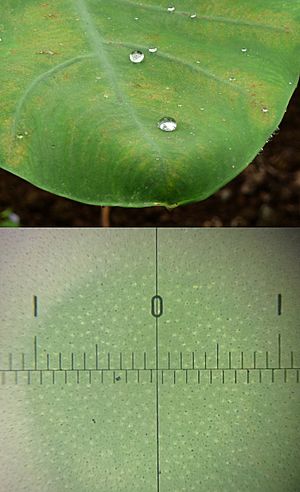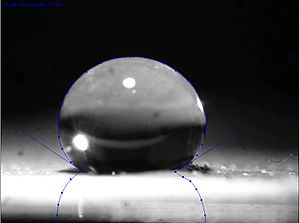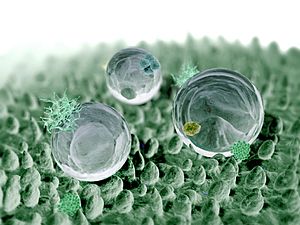Lotus effect facts for kids
The lotus effect is a cool trick that some plants, like the lotus flower, use to keep themselves super clean. It's all about how water behaves on their special leaves. Imagine tiny water droplets rolling over a leaf, picking up dirt as they go, and leaving the leaf spotless! This happens because the leaf surface is incredibly water-repellent, a property called ultrahydrophobicity.
This amazing self-cleaning ability isn't just found in lotus plants. You can also see it on the leaves of plants like Tropaeolum (nasturtium) and Opuntia (prickly pear), and even on the wings of some insects. Scientists first started studying how rough, water-repellent surfaces work in 1964. Later, in 1977, researchers Wilhelm Barthlott and Ehler were the first to describe this special self-cleaning and super water-repellent trick as the "lotus effect." Since the 1990s, many cool uses for this effect have been found in technology.
How the Lotus Leaf Stays Clean

Water naturally tries to form a round shape, like a tiny ball. This is because of something called "surface tension," which makes water molecules stick together tightly. When a water droplet lands on a surface, it usually spreads out a bit. But on a lotus leaf, something different happens!
The secret to the lotus leaf's self-cleaning power is its special double-layered surface. This surface is very water-repellent, or "hydrophobic." It makes it hard for water to stick to the leaf. This greatly reduces how much of the water droplet actually touches the leaf.
The leaf's outer layer, called the epidermis, has tiny bumps that are about 10 to 20 micrometers tall. (A micrometer is super tiny, much smaller than a human hair!) On top of these bumps are even tinier wax crystals. These wax crystals are what make the surface water-repellent. Together, these bumps and wax crystals create a rough, bumpy surface. It's like the water droplet is sitting on a bed of tiny needles, so it can't really touch the leaf much.
We can measure how water-repellent a surface is by looking at its "contact angle." This is the angle where the edge of a water droplet meets the surface. If the angle is small (less than 90 degrees), the surface is "hydrophilic," meaning water loves to stick to it and spreads out. If the angle is big (more than 90 degrees), the surface is "hydrophobic," meaning water doesn't like to stick and forms a rounder drop.
Some plants, like the lotus, have contact angles up to 170 degrees! This means only a tiny part of the water droplet (less than 1%) actually touches the leaf. When dirt particles land on such a surface, they have very little contact with the leaf. So, when a water droplet rolls by, it's much easier for the dirt to stick to the water than to the leaf. The water droplet simply picks up the dirt and rolls off, leaving the leaf clean!
This self-cleaning effect is super important for plants. It helps protect them from harmful things like fungi and algae growing on their leaves. It also keeps the leaf surface clear so the plant can get enough sunlight for photosynthesis, which is how plants make their food.
Cool Inventions Inspired by the Lotus Effect
Scientists realized that the lotus effect isn't just about the specific chemicals in a lotus leaf. It's about the physical shape and texture of the surface at a tiny, tiny scale (micro- and nanoscopic). This meant they could try to copy this amazing trick to make man-made surfaces that also clean themselves!
Today, scientists and engineers have developed special treatments, coatings, paints, and even fabrics that can stay dry and clean themselves. They do this by making surfaces with tiny bumps and special water-repellent chemicals, just like the lotus leaf.
For example, some companies have made stain-resistant clothes that are inspired by the lotus effect. Tomato sauce, coffee, and red wine can be easily washed away from these fabrics, even after many washes! This technology could also be used for things like self-cleaning awnings or sails, which often get dirty quickly.
Scientists have even used powerful lasers to create the lotus effect on metals. These special metals could be used for things like solar energy collectors that stay clean on their own. They might also be used to make self-cleaning toilets, which could help stop the spread of diseases.
This amazing natural trick has inspired many useful inventions that help us keep things clean and dry!
See also
- Biomimetics
- Petal effect
- Salvinia effect




